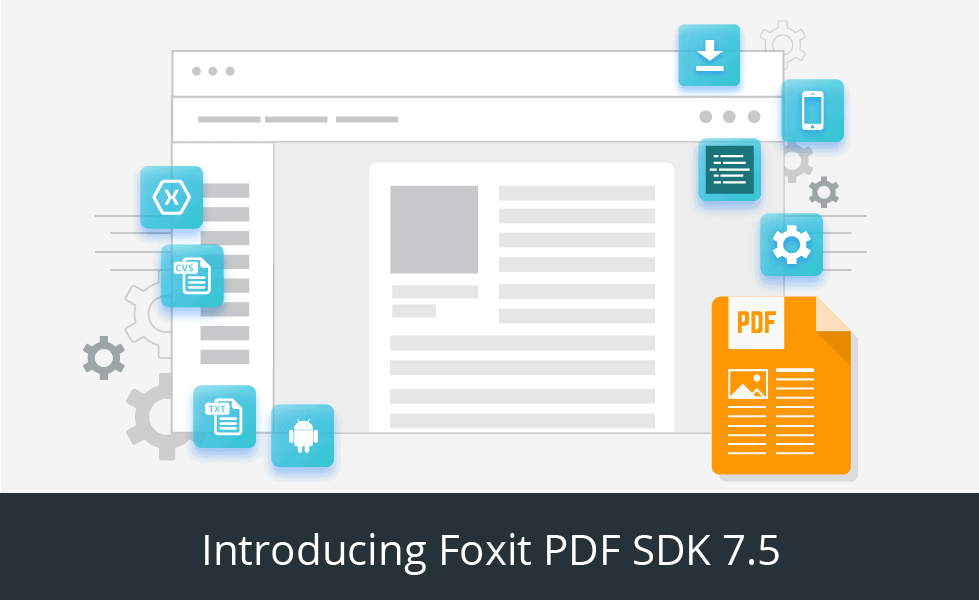Introducing Foxit PDF SDK 7.5

We’re proud to announce Foxit PDF SDK 7.5 to our customers. Our final release of 2020 comes packed with new features, enhancements and further upgrades. Read on below for more information on this update.
Highlights:
- LAYOUT RECOGNITION ENGINE EXTENDED TO MAC AND LINUX (WINDOWS TOO!)
- NEW WEB SDK FEATURES
- WEB VIEWER UI ENHANCEMENTS
- TOOLBAR BUTTON CONTROL USING ANDROID/IOS CORDOVA PLUGIN
- ADD LANGUAGES WITH ANDROID XAMARIN
Contents
VIEW THE RELEASE PAGE HERE
Layout Recognition Engine Extended to Mac and Linux (Windows too!)
Foxit PDF SDK now has one of the most advanced elements of Foxit’s document layout and recognition core engine, used by PhantomPDF’s accessibility functionality. The powerful layout recognition class scans your entire documents and outputs the content of all pages in a comprehensive structure accessible to your own application. Create workflows using the engine and maximize your application’s PDF processing potential now on Linux and Mac, as well as Windows. Take a look at the video below of our newest accessibility feature where text is read aloud after processing the document (audio on!):
New Web SDK features
We’ve put a major focus on our Web PDF library for this release and our annotations and forms in particular. On the annotation side, our new widget class allows the separating of annotations by multiple properties as well as the following:
- Undo/redo an annotation’s actions with one caller
-
- Related API: `pdfui.callAddonAPI(“UndoRedoAddon”,”undoAll”)`
- Programmatically set screen annotation images
-
- Related API: Screen.setImage
- Programmatically retrieve and activate a specified annotation
-
- Related API: PDFViewer.activateAnnotation
- Expose annotation dictionary to enable users to store custom data in the annotation
-
- Related APIs: `setDictionaryEntry(key,value)` and `getDictionaryEntry(key)`
- Enable/disable tooltip on mouse hover on annotation
-
- Related option: PDFViewer.options.showAnnotTooltip
- New event for monitoring annotation’s position change
-
- Related event: annotationMovedPosition
When it comes to Web forms, we’ve added the following updates:
- New classes have been added to better control form field data
-
- Related classes: PDF.annots.Widget, PDF.Form.PDFControl
- New form data format support for CSV and TXT
-
- Related API: `PDFDoc.importFormFromFile()` and `PDFDoc.exportFormToFile()`
- Enable/disable form field automatic calculation right after users input
-
- Related API: PDFViewer.setAutoCalculateFieldsFlag
Web Viewer UI Enhancements
The Web PDF SDK UI has had a major upgrade in this release to give you more flexibility and control without any additional code needed and comes with the following additions:
- New zoom mode ‘Fit Visible’ added
- Sort comments with options such as ‘Page’, ‘Type’, ‘Author’, ‘Date’, ‘Status’, and ‘Check Status’
- Filter comments by status and author
- New features added for the form UI:
- New import/export form data which now support CSV and TXT
- Form field properties editing:
- Set tooltip
- Set flags: ‘Visible’, ‘Hidden’, ‘Visible but unprintable’, ‘Hidden but printable’
- Set direction: Right-to-Left and Left-to-Right
- Set text field: Text Rotation, Font Size/Color and Type (14 standard font types)
- Set actions after placing a signature by adding a new signed tab
- Copy/Cut/Paste the current form field
- Shortcut keys for form fields
- Arrow keys Up/Left/Down/Right for navigating the radio button in a group
- Enter key to activate/deactivate the current form field
The newly added PDFControl class easily identifies and manage different field types in your project.
TOOLBAR BUTTON CONTROL USING ANDROID/IOS CORDOVA PLUGIN
ADD LANGUAGES WITH ANDROID XAMARIN
We’ve updated the documentation of the main developer guides to include newly added functionality as well as the updated JavaScript that we support, plus enhanced JavaScript instructions. View our updated documentation here.
Beyond this, a number of bugs have also been fixed to ensure that our PDF SDK is the most secure on the market.
For more information please view our release page here or take a trial today to see it for yourself.
